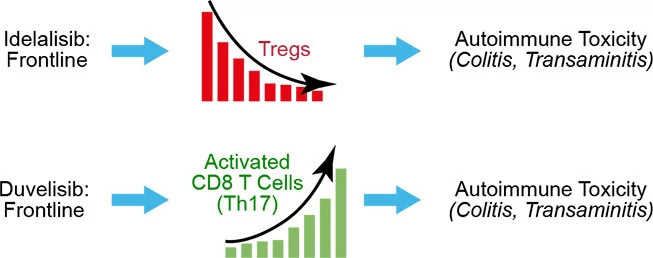When PI3Kδ inhibitors first entered clinical development, their clinical activity in chronic lymphocytic leukemia (CLL) and non-Hodgkin lymphoma (NHL) was notable and generated a high level of excitement. As their use became more widespread and moved into earlier lines of therapy, however, unusual toxicities became evident. The most notable toxicities were a delayed transaminitis and even more delayed rash, diarrhea/colitis and pneumonitis, along with infections. As a result, the PI3Kδ inhibitor class of targeted therapies has not reached its clinical potential.
These toxicities have complicated not just clinical management but also clinical development, which largely failed to take account of our knowledge of appropriate patient selection and toxicity management – first when early-line registration trials of idelalisib were closed due to an excess of infectious deaths in the absence of prophylaxis, and more recently when umbralisib was withdrawn from the market due to a small excess of COVID deaths on the investigational umbralisib-anti-CD20 arm of its CLL registration trial. Our work has focused on understanding the toxicity and efficacy of these drugs, with the goal of rational trial designs to optimize this drug class.
We and others described early on that the classic toxicities of transaminitis and colitis were likely autoimmune based on their timing, responsiveness to steroids and association with T cell infiltration in the affected organ. They were also similar to the autoimmune phenotype seen in mice carrying a PI3Kδ knockout, suggesting they may be an on-target toxicity. We further demonstrated that clinical risk factors for toxicity include younger age and lack of prior therapy. In one of our initial studies looking at a frontline cohort of patients treated with the first-in-class PI3Kδ inhibitor idelalisib, we were able to show that a rapid reduction in Tregs during the first month on therapy was associated with early autoimmune hepatitis. This reduction in Tregs is similar to the mouse phenotype.
Much of our recent clinical work has focused on the PI3Kδ,γ inhibitor duvelisib, including a frontline trial in which we combined duvelisib with fludarabine, cyclophosphamide, rituximab (FCR) chemoimmunotherapy, for the treatment of young, fit CLL patients, led by Matthew Davids, MD. This regimen was highly effective, with a 66% rate of undetectable MRD in bone marrow, but about one-third of patients did develop significant autoimmune toxicity, including not just colitis and transaminitis but several cases of arthritis. In order to understand the T cell changes underlying these toxicities, we focused on changes in T cell subsets in patients with earlier, more severe toxicity as compared to those with no or later toxicity, using CyTOF.
In this study, naïve CD8 T cells at baseline declined, evolving to activated granzyme positive CD8 T cells that increased with treatment selectively in patients with toxicity. A subset of these CD8 T cells showed Th17 differentiation, a subset commonly associated with autoimmune disease. Furthermore, CD4 T cells with Th17 differentiation increased significantly with treatment, again driven mostly by a significant change in the patients with toxicity. Interestingly, we saw a lower baseline level of Tregs in patients who developed toxicity, and a higher baseline level of T cells with Th17 differentiation.
Based on this work, we therefore believe that the toxicity of PI3Kδ inhibitors may be related to lower levels or loss of Tregs, which then allows Th17 cells to become activated and trigger toxicity. We are currently exploring whether we have similar findings with newer generation PI3Kδ inhibitors, namely umbralisib and zandelisib, and whether punctuated schedules of administration may preserve the baseline Th17:Treg balance. Recent work using zandelisib has demonstrated that an intermittent schedule of administration substantially reduces autoimmune toxicity in patients, and we are currently exploring the effects of that schedule on T cell modulation by the drug. We are also exploring options for targeting the Th17 pathway to reduce toxicity. The ultimate goal of our work is to better predict and prevent the toxicities which have limited the use of these drugs in clinical practice, so that our patients can achieve the full benefit of this highly active class of drugs.

